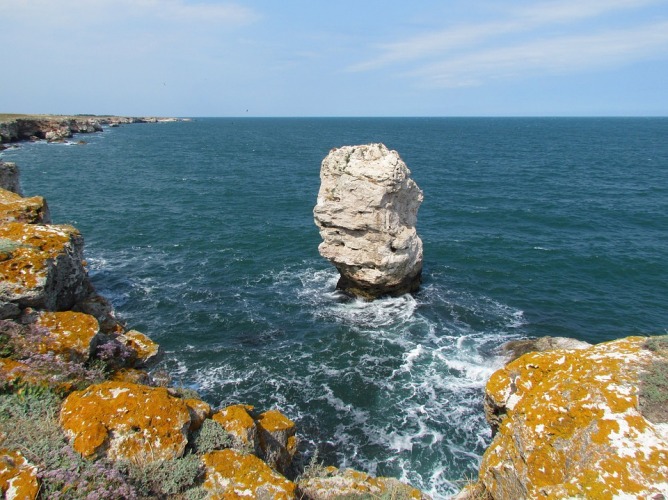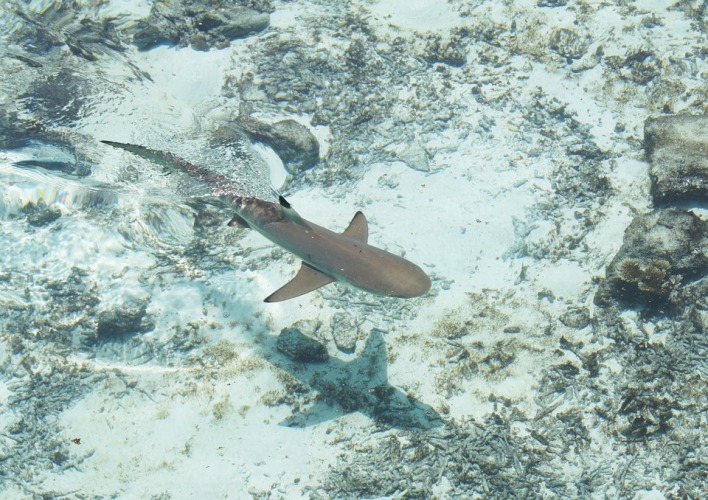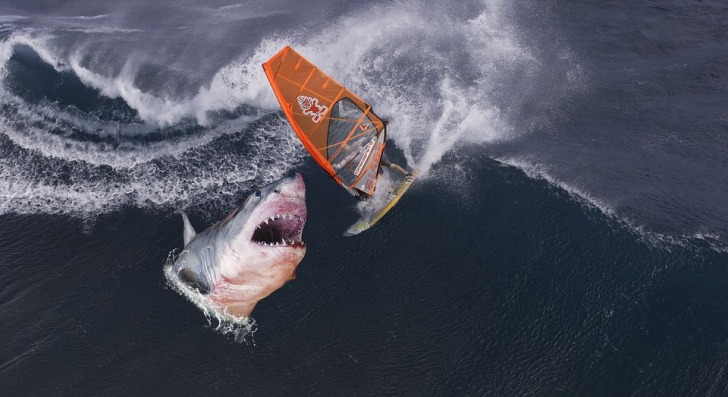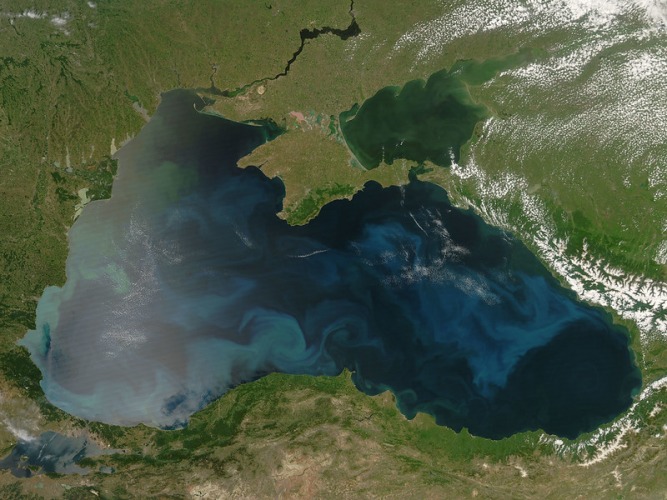The Black Sea is recognized as an inland sea and one of the major bodies of water in the world.
Its name refers to what was once a challenging and inhospitable body of water to navigate.
The Black Sea is fed by the Atlantic Ocean and some of Europe’s longest and largest rivers.
It is also connected to the Sea of Azov.
The Black Sea empties into the Mediterranean Sea – home to nearly four dozen shark species, which is a conduit for sharks to travel to the Black Sea.
The Black Sea is home to more than 200 species of fish, of which more than three-quarters are endemic.
The remaining inhabitants are guests (or invaders) from other bodies of water that connect to the Black Sea.
Several countries share the coastline of the Black Sea, which stretches across an area between the continents of Asia and Europe – covering approximately 168,500 square miles.
Along the Black Sea’s coastline, important urban cities include Odesa, Ukraine, Poti, Georgia, Istanbul, Turkey, Constanta, Romania, and Burgas, Bulgaria.
Its maximum depth is an impressive 7,257 feet – more than 1 1/3 miles.
Contents
So… Are There Sharks in the Black Sea?
Yes, there are sharks in the Black Sea.
The Black Sea is also known as the Euxine Sea, which is its Greek Name.
However, the Black Sea pales in comparison to the amount (or variety) of sharks that inhabit the Mediterranean Sea, the Pacific, and Atlantic Oceans.
Sharks in the Black Sea (and other Eastern Europe locations) tend to be smaller and have fewer population numbers, making a sighting relatively rare for tourists and even scientific researchers in pursuit of academic study.
But note that the lower and upper water layers of the Black Sea do not mix because the Black Sea has a meromictic basin – with most of the water on the lower levels anoxic – lacking dissolved oxygen.
As such, there is no marine life except near the surface because it becomes quite unfriendly below this level.

The Spiny Shark or Spiny Dogfish
The Spiny Dogfish, known in Russian as the ‘Katran,’ is believed to be the largest and most productive in the world and is thus, the most common species of shark in the Black Sea.
Spiny Dogfish in the Black Sea, compared to those in the Atlantic Ocean, grow larger and give birth to twice as many pups.
Further, Spiny Sharks in the Pacific and Atlantic oceans are pregnant twice the time as Black Sea Spiny Sharks.
This shark is the slowest growing on the planet, which tends to make them vulnerable to exploitation.
Spiny Dogfish are pack hunters, and they prefer colder water, so in the summer, they remain in the colder water levels that are below the thermocline – a transitional layer of water between the mixed warmer surface and the deeper, cooler water.
This generally happens at a depth of at least 20 meters deep.
It is not unusual to find more than 1,000 Spiny Dogfish preying on squid or jellyfish.
The Small-Spotted Catshark
The Small-Spotted Catshark is essentially harmless to humans.
In addition to the Black Sea, the Small-Spotted Catshark is found as far as Norway and the North Sea, as well as southern points near the Greek Islands.
With a full length of about one meter, this shark can be dark grey, black, and pale white but always with spotted fins and torso – hence the name.
The Small-Spotted Catshark is a ubiquitous inhabitant of Europe, including Romanian, Russian, Bulgarian, and Turkish coastlines.
They tend to have a preference for shallow water where they opportunistically prey on sea snails and mollusks.
The three shark types noted below have been seen in the Black Sea but rarely pose minimal risk to swimmers.
Note, though the following shark species cannot settle or stay in the Black Sea as its low salinity and colder water make for an inhospitable environment.
The Smooth Hammerhead Shark
Most Smooth Hammerhead Sharks are found in the Mediterranean Sea and the Atlantic Ocean; however, many believe they may be seen further north as they migrate seasonally to cooler water.
But note, if you see a Smooth Hammerhead Shark, you will immediately know it by its size and elongated hammerhead.
The Smooth Hammerhead Shark is considered the 2nd largest shark at five meters in length, with the Great Hammerhead, the largest shark.
Smooth Hammerhead Sharks can be dangerous to humans as they are aggressive and territorial – plus, they have two rows (on each side of its jaw) of serrated teeth.
The Longnose Spurdog
Although quite similar in appearance to the Spiny Dogfish, the Longnose Spurdog is a rarer species in the Black Sea.
The Longnose Spurdog is more commonly found off the coasts of Australia, Africa, and the Canary Islands.
The Longnose Spurdog inhabit deeper waters – at least 50 meters beneath the surface, although they have been seen as far as 1,500 meters.
Unfortunately, the Longnose Spurdog are a primary fishing target, and their meat is eaten on a global basis.
Their population numbers have declined dramatically.
The Common Thresher
The Common Thresher has been seen in the Black Sea as well as the Mediterranean and Aegean Seas.
As a result, the Common Thresher is among the more widespread shark species in Europe.
They prefer cool-to temperate waters that can be found from California to Brazil.
The Common Thresher is easy to spot.
They can grow to six meters, with their caudal fin pointing in the air – similar to a Swordfish.

Is it Safe to Swim in the Black Sea?
Yes.
The Black Sea is friendly to swimmers of all ages if they prepare appropriately.
If a shark is spotted in the Black Sea, it is likely to be a Spiny Dogfish as they are the most common – recognizable by their dull brown/grey color and a dorsal fin that points.
Spiny Dogfish sharks are not a serious threat to swimmers and those who live and visit on the coast of the Black Sea.
The only true danger they pose may be caused by its spiny fins – a placoid scale covering the shark’s skin – resembling bones and teeth in structure and strength.
Interesting Shark Facts in the Black Sea
The name of the Spiny Shark genus is sourced from the word Squalidus – which means covered in calloused skin.
The scales are like dotted sharp teeth nestled next to one another.
As such, rubbing the shark in one direction (head to tail) may be smooth, but it feels like sandpaper if rubbed in the opposite direction (from tail to head).
The term caviar originally referred to Wild Sturgeon roe that is from the Black or Caspian Seas.

Sharks are cartilaginous fish.
Sharks, skates, and rays are part of the subclass Elasmobranchii of the class Chondrichthyes.
Overall, sharks make up 5% of marine fish species.
Most sharks can only live in saltwater, as the salinity provides the necessary buoyancy for their heavy structures.
But note, several shark varieties have adapted over time to be able to live in freshwater.
The temperature of the water’s surface in which they inhabit categorizes these shark types.
Polar Sharks inhabit the frigid waters near or at the polar ice caps.
A Dogfish Shark is an example of a polar shark.
Tropical Sharks, as its name suggests, tend to prefer warm water in and around the equator.
An example of a tropical shark is the Great Hammerhead – best known for its 360-degree vision.
Temperate Sharks are adaptable as they live and migrate to both types of environments.
The Great White Shark is a temperate shark that may migrate to tropical waters.
The following are examples of freshwater sharks found throughout the world:
- Bull Shark – these sharks are strong swimmers and are often found in freshwater lakes that have a connection to a river. Bull Sharks are deadly and swim in shallow waters near swimmers.
- Speartooth Shark – the Speartooth Shark is found in and around Australia and Papua New Guinea. The Speartooth Shark is quite rare, which is good because the Speartooth Shark’s upper and lower jaws have 29 rows of teeth.
- Ganges Shark – the Ganges Shark, is native to India’s rivers and is now endangered.
- Borneo River Shark – Borneo River Sharks, are typically small (2 feet or less) and are ranked as one of the rarest of freshwater sharks.

3 Safety Tips for Swimming in Shark-infested Waters
Shark attacks make headlines but happen much more rarely than most people believe.
There were 129 cases reported globally of shark attacks.
Consider these safety tips if you plan to swim in a sea, lake, or ocean where you may face a shark:
- Avoid the water at dawn, dusk, and nighttime. These are a shark’s primary feeding times where low lights may cause you to look like prey mistakenly.
- If you are near a shark, do not make sudden movements. Move slowly in the direction of the shore without turning your back on the shark. If you are in the shark’s path, move slowly away.
- Do not swim if you are bleeding. Sharks can smell blood from hundreds of miles away.
Summary
The Black Sea is an inland sea and one of the major bodies of water in the world.
It offers incredible scenery and more than 200 types of marine creatures, including sharks.
However, the sharks in the Black Sea tend to be smaller than their counterparts in other parts of the world and are mostly not dangerous to humans unless provoked.
The most commonly found shark in the Black Sea is the Spiny Dogfish.
Other shark varieties include the Small-Spotted Catshark, the Smooth Hammerhead Shark, the Longnose Spurdog, and the Common Thresher
Swimming in the Black Sea is safe if you heed swimmer warnings and guidance.
Sources
- https://www.maritimemanual.com/facts-about-the-black-sea/
- http://www.aquaticlifelab.eu/3-8-elasmobranch-species-in-the-mediterranean-sea/
- https://www.britannica.com/place/Sea-of-Azov
- http://justfunfacts.com/interesting-facts-about-the-black-sea/
- https://oxfordre.com/classics/view/10.1093/acrefore/9780199381135.001.0001/acrefore-9780199381135-e-2593
- https://www.guinnessworldrecords.com/world-records/82693-largest-meromictic-basin
- https://www.owp.csus.edu/glossary/anoxic.php
- https://www.britannica.com/animal/spiny-dogfish
- https://oceanservice.noaa.gov/facts/thermocline.html
- https://marinedimensions.ie/small-spotted-catshark-fact-file/
- https://www.sharks.org/smooth-hammerhead-sphyrna-zygaena
- https://www.sharkwater.com/shark-database/sharks/long-nose-spurdog/
- https://www.sharkwater.com/shark-database/sharks/common-thresher-shark/
- https://animaldiversity.org/accounts/Squalidus/classification/
- http://justfunfacts.com/interesting-facts-about-the-black-sea/
- https://www.britannica.com/animal/elasmobranch
- https://www.britannica.com/animal/chondrichthian
- https://www.blueplanetaquarium.com/blog/sharks/where-do-sharks-live/
- https://theaquariumguide.com/articles/freshwater-sharks-real-sharks
- https://www.nationalgeographic.com/animals/fish/facts/bull-shark
- https://nt.gov.au/__data/assets/pdf_file/0009/206388/speartooth-shark.pdf
- https://india.mongabay.com/2020/06/the-rare-shark-of-the-ganga/
- https://animals.fandom.com/wiki/Borneo_River_Shark
- https://www.floridamuseum.ufl.edu/shark-attacks/yearly-worldwide-summary/
- https://www.nhm.ac.uk/discover/megalodon–the-truth-about-the-largest-shark-that-ever-lived.html
- https://www.sea.museum/2020/01/16/ten-interesting-facts-about-sharks
Frequently Asked Questions
Is it true some sharks communicate by releasing glowing light in the dark?
Yes, in 2014, it was discovered that certain sharks emit fluorescent green light that can only be seen when looking through a blue light filter.
In 2019, scientists learned that the glow was generated from molecules that transform how light reflects on the skin of the shark.
What was the largest shark to have lived?
The megalodon, a close relative of the great white shark, lived about 20 million years ago.
Fossils confirm that they could grow to nearly 18 meters (three times longer as a great white shark) and weigh up to 55,000 lbs.!
Its jaw could open to more than 3 meters, allowing it to swallow two adult people standing side-by-side.
Depending on the species, Sharks can lose and replace up to 35,000 teeth during their life.












Great info..Especially about the Bull Sharks in fresh water being fed by a river. I heard a story long ago of attacks in the Lake Erie area but confirms the on going possibility in fresh water. Also thank you for making it possible to comment without having to open up my personal info to make a comment. I avoid the common medias so as not to have my computer invaded more than usual.
I am so glad to learn how safe from shark attacks is the Black Sea (Euxine Sea)! When I was in the area, I went to its Romanian shores every year for 2 weeks and it healed me of asthma! I did that for about 7 years!